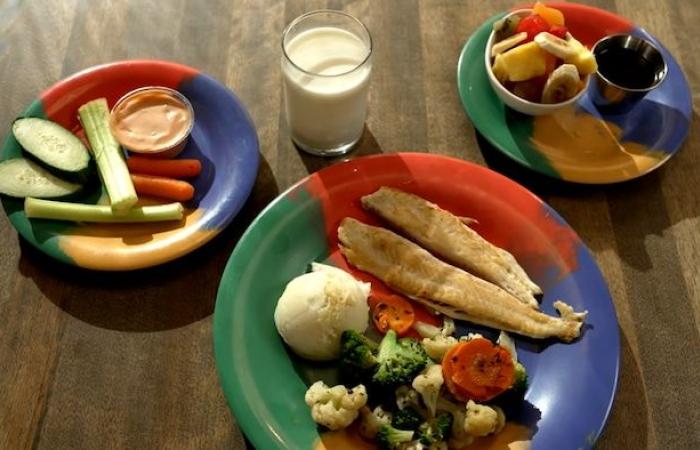When eating out, it’s easier and easier to eat healthily when you’re an adult. But when you are a child, the meal offering remains limited and is often too fatty, too salty or too sweet.
The grocery store asked nutritionist and food marketing expert Isabelle Marquis to analyze the children’s menus of 17 major family restaurant chains.
His findings are striking.
First, there is very little variety for little ones. In the menus intended for them, we find an average of six dishes, unlike the menus for adults, which are made up of several pages of meals.
The offer is generally very conservative. It surprises me that we’re still here, when young people today taste so many things
says Isabelle Marquis
Of the 106 dishes analyzed by The grocery storehalf is two things: pasta or breaded chicken.
When we look at the proteins found on the menus, whether chicken or fish, one dish out of two is offered in a breaded version.
And when we add the most popular side dish, fries, 70% of the offerings on children’s menus contain fried or breaded ingredients.
70% of the offerings in children’s menus contain fried or breaded ingredients. It’s huge!
Open in full screen mode
The meal offering remains limited in children’s menus. Too often, these meals contain frying or breading.
Photo: - / The grocery store
Why so few choices? This is because the children’s menu is considered a element of seduction
by restaurateurs.
It brings very little, if any, profit to the restaurant, but it helps attract adult customers.
To ensure that the children’s menu is kept at a reasonable price and to avoid food waste, restaurateurs rely on sure values
easy to prepare.
Raw vegetables and fish on the menu
However, one restaurant stands out from the others, according to Isabelle Marquis, first of all by the variety of dishes offered: Normandin. For several years, the chain has offered 15 dishes to children who eat there: 11 type dishes supper
and four type dishes lunch
but available all day.
We regularly survey our customers and adapt to their requests. Families asked for more choice. Is fish what comes out the most? No, but we want to keep it anyway to offer the child a choice.
Open in full screen mode
Normandin offers a wide variety of children’s menus.
Photo: - / The grocery store
Other appreciable elements, according to Isabelle Marquis, are the raw vegetables included as a starter, the choice of side dishes which include several varieties of vegetables and the two healthy desserts offered which are composed of fresh fruit or yogurt.
Drink and dessert included: a practice to review?
Regardless of the restaurant analyzed, one aspect that deserves reflection, according to Isabelle Marquis, is the often automatic inclusion of a drink and a dessert when ordering children’s meals.
Knowing that we have a public health problem of overconsumption of sugar among children, adding this to the menu annoys me and it significantly increases sugar consumption.
The World Health Organization (WHO) recommends limiting sugar intake to 24 g or two tablespoons per day for a child aged 7 to 10.
Some desserts far exceed this daily recommendation.
-

Open in full screen mode
This dessert, appearing in a children’s menu, far exceeds the daily recommendation of 24 g of sugar for a child aged 7 to 10.
Photo: - / The grocery store
-

Open in full screen mode
This dessert, appearing in a children’s menu, far exceeds the daily recommendation of 24 g of sugar for a child aged 7 to 10.
Photo: - / The grocery store
This dessert, appearing in a children’s menu, far exceeds the daily recommendation of 24 g of sugar for a child aged 7 to 10.
Photo: - / The grocery store
This dessert, appearing in a children’s menu, far exceeds the daily recommendation of 24 g of sugar for a child aged 7 to 10.
Photo: - / The grocery store
Photo album: Dessert time
However, is it the role of restaurateurs to feed their customers healthily? Opinions differ on this question. Some observers believe that it would be appropriate to adopt regulations to limit the availability of junk food aimed at children in restaurants.
According to Isabelle Marquis, however, the mission of restaurants is above all to allow people to have a good time and enjoy themselves without having to prepare, serve and then clean up.
They do what their customers ask. As long as customers do not demand a healthier and more diversified offering, they will continue to offer what is expected of them, that is to say comforting, tasty and inexpensive dishes.
she emphasizes.
Pleasure of eating and junk food
The majority of children’s menus too often combine the pleasure of eating and junk food. An association which is strongly anchored in the collective imagination, according to Isabelle Marquis, in particular because it passes from generation to generation.
It’s not a fashion. It’s part of our North American culture to treat ourselves by eating something that we know is not healthy, but which is so pleasant for the taste buds!
But she believes the tide is turning. There is a way to turn several of these menus into healthier and healthier versions, just as fun and colorful, but less caloric and less sweet, and to send a signal to both young people and parents that it is possible to eat healthily while having a lot of pleasure and that it is different from what we eat at home .

Open in full screen mode
“The grocery store” has noted that, in children’s menus, we too often associate junk food with the pleasure of eating.
Photo: - / The grocery store
She adds that feeding children a restricted list of highly processed foods perpetuates the idea that children are naturally picky eaters, which dampens their curiosity and limits their opportunities to try new things.
Especially since the scientific literature of recent years proves that eating habits acquired during childhood are likely to continue into adulthood.
Many children met by The grocery store are also demanding change and say they are open to much healthier meals. See the full report on our website.












